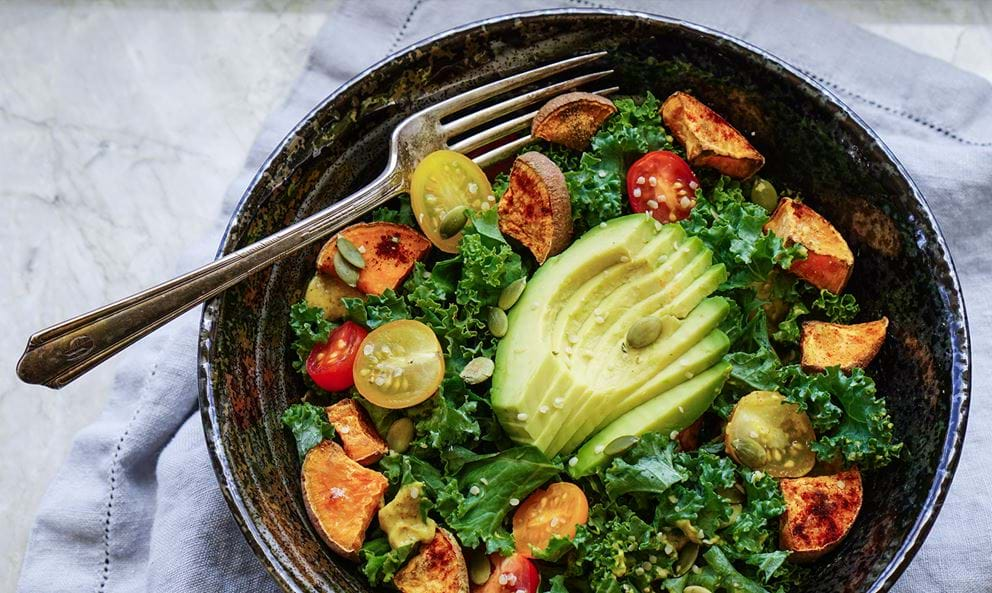The Truth About Superfoods

“Superfood” is one of those hot health terms which has been all over the place for a few years now. The basic idea is hard to miss — there are some foods which just do more than a normal food can.
So, do these foods live up to the hype or not?
What are they really good for?
Here, we’ll take a look at a few of the leading and currently popular superfoods to answer that question.
Kale
Why is it supposed to be super?
You’ll probably never read a list of superfoods without finding kale listed somewhere near the top.
This humble leafy green has been extolled for having enormous nutrient density, with very few calories and a ton of antioxidants. Some of the more serious kale enthusiasts don’t stop far short of claiming that it’s the elixir of eternal youth.
Does it live up to the hype?
Simple answer: yes.
Kale contains around 49 calories per 100g serving[1]. This makes it more than twice as calorically dense as spinach[2], though that’s not saying much.
The nutritional profile of kale does a pretty good job of living up to the hype. Each serving of kale will net you impressive quantities of minerals such as calcium, iron, magnesium, potassium, sodium and zinc, as well as a suite of vitamins, including A and B vitamins, vitamin C (almost 5 times as much as in spinach), and massive amounts of vitamin K
Kale clearly is as healthy as everyone claims, but there are a couple of caveats. Those taking blood thinning medication are generally advised to avoid kale and similar leafy greens due to their high vitamin K content (vitamin K encourages blood to clot).
Many people may also find the texture of kale to be unpalatable. It’s a rough plant which doesn’t tend to go down well raw. Work around this by trying different cooking methods.
Quinoa
Why is it supposed to be super?
Quinoa, apparently the source of the ancient Incan warriors’ strength, is often hailed as a superfood, mainly due to its status as a complete protein (containing all the essential amino acids). It also gets praise for its high fibre content and naturally gluten-free nature — making it a healthier alternative for anyone who struggles with gluten sensitivity.
Does it live up to the hype?
First things first, quinoa is a complete protein source, making it one of the few plant foods to tick that box. (By contrast, all meats are complete protein sources).
It’s important to keep in mind, though, that while quinoa is a complete protein source, it’s still not actually very high in protein. A 100g serving of quinoa will only net you around 4.4g of protein[3], whereas 100g of lentils would net you 9g of protein[4], and 100g of beef would net you 26g of protein[5].
Quinoa is a great plant protein source, particularly useful for vegetarians and vegans, but it probably won’t be enough to meet your daily protein needs by itself.
It is also true that quinoa is naturally gluten free, making it a great option for those suffering gluten sensitivity. However, certain groups such as glutenfreesociety.org raise concerns that quinoa is often processed in the same facilities which handle gluten products, and so becomes contaminated with gluten as a result.[6]
This may be less of an issue in the UK than in the US, but one US-focused study did find that 41% of ‘gluten-free’ foods tested had been heavily contaminated with gluten.[7]
For this reason, you should be careful about how you source your quinoa, to ensure it really is gluten free.
Chia Seeds
Why is it supposed to be super?
The main reasons these little seeds get so much attention as a superfood are their amazingly high Omega 3 fatty acid content on the one hand, and their enormous fibre and antioxidant content on the other. The story goes that chia seeds actually contain more Omega 3’s than salmon, the king of oily fish, gram-for-gram.
Does it live up to the hype?
In terms of its Omega 3 content, chia seeds certainly seem to live up to the hype at first glance. Take a closer look, however, and things are more complicated. While chia seeds are chock full of Omega 3s, those mostly take the form of Alpha Linolenic Acid (ALA).
ALA needs to be converted into the active forms DHA and EPA in order to be utilised in the body. And the body doesn’t do a great job of carrying out this conversion. It’s for this reason that studies show plant sources of Omega 3 being vastly inferior to animal (especially fish) sources.[8]
DHA is the most important and beneficial Omega 3. Studies show that while chia seeds can raise the body’s levels of ALA and EPA, they don’t raise DHA.[9]
Unfortunately, chia seeds don’t live up to the hype as far as Omega 3’s are concerned.
When it comes to fibre, chia seeds absolutely live up to the hype.
100g of chia seeds contain around 42g of carbs, but almost all of those (34g) are in the form of fibre.[10] Fibre is known to be incredibly beneficial for gut health, and therefore, for overall health.[11]
[1] https://ndb.nal.usda.gov/ndb/foods/show/2983?fgcd=&manu=&lfacet=&format=&count=&max=50&offset=&sort=default&order=asc&qlookup=11233&ds=&qt=&qp=&qa=&qn=&q=&ing=
[2] https://ndb.nal.usda.gov/ndb/foods/show/3167?fgcd=&manu=&lfacet=&format=&count=&max=50&offset=&sort=default&order=asc&qlookup=11457&ds=&qt=&qp=&qa=&qn=&q=&ing=
[3] https://ndb.nal.usda.gov/ndb/foods/show/6587
[4] https://ndb.nal.usda.gov/ndb/foods/show/4808?fgcd=&manu=&lfacet=&format=&count=&max=50&offset=&sort=default&order=asc&qlookup=16070&ds=&qt=&qp=&qa=&qn=&q=&ing=
[5] https://ndb.nal.usda.gov/ndb/foods/show/7612?fgcd=&manu=&lfacet=&format=&count=&max=50&offset=&sort=default&order=asc&qlookup=23568&ds=&qt=&qp=&qa=&qn=&q=&ing=
[6] https://www.glutenfreesociety.org/is-quinoa-a-safe-gluten-free-food-alternative/
[7] https://www.ncbi.nlm.nih.gov/pubmed/20497786?dopt=Citation
[8] https://www.ncbi.nlm.nih.gov/pubmed/9637947
[9] https://www.ncbi.nlm.nih.gov/pubmed/22538527
[10] https://ndb.nal.usda.gov/ndb/foods/show/3610
[11] http://advances.nutrition.org/content/4/1/16.full


